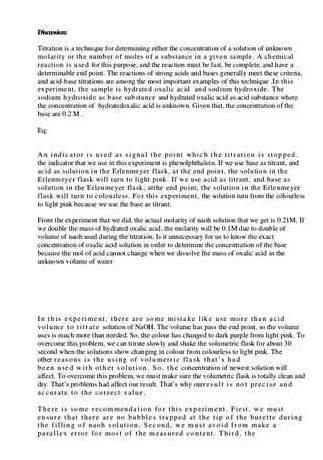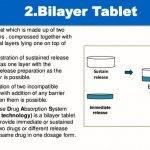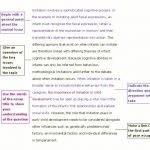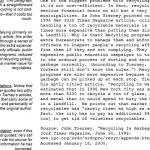Writing the Discussion
The discussion section is a framing section, like the Introduction, which returns to the significance argument set up in your introduction. So reread your introduction carefully before writing the discussion; you will discuss how the hypothesis has been demonstrated by the new research and then show how the field’s knowledge has been changed by the addition of this new data. While the introduction starts generally and narrows down to the specific hypothesis, the discussion starts with the interpretation of the results, then moves outwards to contextualize these findings in the general field.
The Discussion section is sort of an odd beast because it is here where you speculate, but must avoid rambling, guessing, or making logical leaps beyond what is reasonably supported for your data. The solution that has evolved over time is to set up the Discussion section as a “dialogue” between Results and Theories — yours and everyone elses’. In other words, for every experimental result you want to talk about, you find results from other publications bearing the relationship to your result that you want the reader to understand. Most often, your result either agrees with (corroborates), extends. refines. or conflicts with the other result. This is how the new data you’ve generated is “situated” in the field — by your careful placement of what is new against that which is already known. Results can take the form of data, hypotheses, models, definitions, formulas, etc. (I imagine the Results section like a dance with swords — sometimes you are engaging your partner with the pointy end and sometimes you are gliding along side them).
Generally speaking, the organization is as follows (examples from Rothschild, G. Nelken, I. Mizrahi, A. (2010). Functional organization and population dynamics in the mouse primary auditory cortex. Nature Neuroscience, 13, 353-360, DOI:10.1038/nn.2484 ):
1. Begin with a restatement of your research question, followed by a statement about whether or not, and how much, your findings “answer” the question. These should be the first two pieces of information the reader encounters.
RQ: How similar or variable are the response properties of neighboring neurons in A1? Are there any obvious organizational principles in local populations? And to what extent are the responses of individual neurons in the network independent or correlated?
1st paragraph Discussion. In vivo two-photon calcium imaging enabled us to characterize the functional architecture of neuronal populations in layer 2/3 of the mouse primary auditory cortex with high precision. Because neighboring cortical neurons (100 μm apart) have a high probability of sharing common input 21, 22 and being synaptically connected 21, 22, 23. one might expect that local populations of neurons would be homogeneous in their response properties. However, our data revealed a highly heterogeneous local population in which neighboring neurons could have very similar or very different response properties .
2nd paragraph Discussion. Despite the local disorder, large-scale organizing principles do exist. Tonotopy and gradual decrease of signal correlation with distance were found when examining larger distances.
It thus seems that local heterogeneity is embedded in larger-scale order in A1. Furthermore, imaging dozens of neurons simultaneously allowed us to unravel temporal interactions between thousands of neuronal pairs as measured by noise correlations. Despite the heterogeneous organization with regard to signal correlation, neurons tended to have similar noise correlation during on-going and tone-driven activities, suggesting that noise correlations reflect structure in the local network (see below).
2. Relate your findings to the issues you raised in the introduction. Note similarities, differences, common or different trends. Show how your study either corraborates, extends, refines, or conflicts with previous findings.
Recently, electrophysiological experiments have shown that responsive and unresponsive neurons are located in nearby penetration sites (
50100 μm apart) and even along a single penetration site from different cortical layers 9. Our results support and augment these findings by showing that nonresponsive neurons are an integral part of L2/3 networks in A1 at single-cell resolution. These neurons might be involved in something other than simple pure-tone coding, such as processing of complex sound features 32 .
Third, heterogeneity was manifested as a lack of local organization according to best frequency (Figs. 4 and 5). At first, these data seem difficult to reconcile with numerous studies showing smooth, large-scale tonotopic organization in A1 (for example, see A1 tonotopy in ferrets 19. mice 8. rats 18 and monkeys 33 ). In fact, the precision of tonotopic organization in A1 has been a controversial issue for a few decades and remains unresolved to date 9, 34, 35, 36, 37 .
3. If you have unexpected findings, try to interpret them in terms of method, interpretation, even a restructured hypothesis; in extreme cases, you may have to rewrite your introduction. Be honest about the limitations of your study.
Previous reports of smooth tonotopic maps may have resulted from techniques that average the responses over multiple neurons. Electrophysiological studies that reported precise tonotopy used electrode penetrations that were spaced by more than 200 μm and used multi-unit activity to determine frequency tuning 8, 18, 36, 38. Because multi-unit recordings sample spikes from neurons located at distances of up to 100 μm 39. such studies may have observed the larger-scale tonotopy while missing the local diversity of single-neuron responses. Another possible explanation for the apparent discrepancy is a sampling bias of extracellular recordings toward highly active neurons 40. raising the concern that calcium dye loading might be biased as well, penetrating preferably into subtypes of neurons with unique response profiles. Although this concern has not been thoroughly ruled out, it seems unlikely because, in at least one study, GABAergic interneuorns were loaded just as efficiently as neighboring pyramidal neurons using similar methodology 41. Other studies revealing tonotopy using imaging techniques such as intrinsic imaging 7, 42 or voltage-sensitive dyes 43 averaged responses over many neurons and are prone to overlook the local heterogeneity that we found here.
4. State the major conclusions from your study and present the theoretical and practical implications of your study.
Our main finding consists of highly heterogeneous local populations with relatively large correlations between a minority of neighboring neurons. What type of local connectivity might give rise to these results?
The simplest connectivity model to consider would be that of a tonotopic input combined with locally random (noisy) connectivity. This model could partially explain our results, including the heterogeneous micro-architecture and the decrease of signal and noise correlations with distance. Our data, however, put additional constraints on this connectivity model. Specifically, at short distances, a minority of the neurons are coupled rather strongly, whereas such coupling is absent at longer distances. These findings are consistent with the random connectivity model provided that there is at least one component of the overall connectivity that is strong, sparse and decreases fast with distance. Such a model would result in the formation of small subnetworks of highly correlated neurons. partially overlapping in space.
A number of our findings support such a subnetworks model. Notably, a subnetworks model would account for the details of the dependence of signal correlation and noise correlation on distance. Specifically, at short distances we observed both very large and very small correlations, while at longer distances we observed only smaller correlations. In addition. the strong correlation between the signal correlation of pairs of neurons (generally attributed to common input), and the noise correlation between them (generally attributed to direct synaptic connections) supports a model of strongly coupled subnetworks that share common input. Such a model, with partially overlapping, strongly connected subnetworks that share common input, has already been suggested for L2/3 neurons in the visual cortex 50. Finally, our data describing strong correlation between noise correlation during on-going activity and during auditory stimuli support the idea that distributed groups of interconnected neurons are coactivated during tone stimulation .
5. Discuss the implications of your study for future research and be specific about the next logical steps for future researchers.
Although our data seems to best fit the overlapping subnetworks model, it is only one interpretation of our results. Different experimental procedures, including direct mappings of synaptic connectivity in local cortical circuits, would be required to reveal the underlying organizational principles of the auditory cortex.
Stylistically, the Discussion often reads like a set of bulleted points that happen to be written out in paragraph form. Use subheadings if it makes sense; otherwise, worry less about “flow” between sections than you should in the introduction. As tempting as it may be, avoid over-using the grammatical first person. “I” is powerful grammatically and can be intrusive if used too often.
Course Links
Writing the Discussion
The discussion section is a framing section, like the Introduction, which returns to the significance argument set up in your introduction. So reread your introduction carefully before writing the discussion; you will discuss how the hypothesis has been demonstrated by the new research and then show how the field’s knowledge has been changed by the addition of this new data. While the introduction starts generally and narrows down to the specific hypothesis, the discussion starts with the interpretation of the results, then moves outwards to contextualize these findings in the general field.
The Discussion section is sort of an odd beast because it is here where you speculate, but must avoid rambling, guessing, or making logical leaps beyond what is reasonably supported for your data. The solution that has evolved over time is to set up the Discussion section as a “dialogue” between Results and Theories — yours and everyone elses’. In other words, for every experimental result you want to talk about, you find results from other publications bearing the relationship to your result that you want the reader to understand. Most often, your result either agrees with (corroborates), extends. refines. or conflicts with the other result. This is how the new data you’ve generated is “situated” in the field — by your careful placement of what is new against that which is already known. Results can take the form of data, hypotheses, models, definitions, formulas, etc. (I imagine the Results section like a dance with swords — sometimes you are engaging your partner with the pointy end and sometimes you are gliding along side them).
Generally speaking, the organization is as follows (examples from Rothschild, G. Nelken, I. Mizrahi, A. (2010). Functional organization and population dynamics in the mouse primary auditory cortex. Nature Neuroscience, 13, 353-360, DOI:10.1038/nn.2484 ):
1. Begin with a restatement of your research question, followed by a statement about whether or not, and how much, your findings “answer” the question. These should be the first two pieces of information the reader encounters.
RQ: How similar or variable are the response properties of neighboring neurons in A1? Are there any obvious organizational principles in local populations? And to what extent are the responses of individual neurons in the network independent or correlated?
1st paragraph Discussion. In vivo two-photon calcium imaging enabled us to characterize the functional architecture of neuronal populations in layer 2/3 of the mouse primary auditory cortex with high precision. Because neighboring cortical neurons (100 μm apart) have a high probability of sharing common input 21, 22 and being synaptically connected 21, 22, 23. one might expect that local populations of neurons would be homogeneous in their response properties. However, our data revealed a highly heterogeneous local population in which neighboring neurons could have very similar or very different response properties .
2nd paragraph Discussion. Despite the local disorder, large-scale organizing principles do exist. Tonotopy and gradual decrease of signal correlation with distance were found when examining larger distances. It thus seems that local heterogeneity is embedded in larger-scale order in A1. Furthermore, imaging dozens of neurons simultaneously allowed us to unravel temporal interactions between thousands of neuronal pairs as measured by noise correlations. Despite the heterogeneous organization with regard to signal correlation, neurons tended to have similar noise correlation during on-going and tone-driven activities, suggesting that noise correlations reflect structure in the local network (see below).
2. Relate your findings to the issues you raised in the introduction. Note similarities, differences, common or different trends. Show how your study either corraborates, extends, refines, or conflicts with previous findings.
Recently, electrophysiological experiments have shown that responsive and unresponsive neurons are located in nearby penetration sites (
50100 μm apart) and even along a single penetration site from different cortical layers 9. Our results support and augment these findings by showing that nonresponsive neurons are an integral part of L2/3 networks in A1 at single-cell resolution. These neurons might be involved in something other than simple pure-tone coding, such as processing of complex sound features 32 .
Third, heterogeneity was manifested as a lack of local organization according to best frequency (Figs. 4 and 5). At first, these data seem difficult to reconcile with numerous studies showing smooth, large-scale tonotopic organization in A1 (for example, see A1 tonotopy in ferrets 19. mice 8. rats 18 and monkeys 33 ). In fact, the precision of tonotopic organization in A1 has been a controversial issue for a few decades and remains unresolved to date 9, 34, 35, 36, 37 .
3. If you have unexpected findings, try to interpret them in terms of method, interpretation, even a restructured hypothesis; in extreme cases, you may have to rewrite your introduction. Be honest about the limitations of your study.
Previous reports of smooth tonotopic maps may have resulted from techniques that average the responses over multiple neurons. Electrophysiological studies that reported precise tonotopy used electrode penetrations that were spaced by more than 200 μm and used multi-unit activity to determine frequency tuning 8, 18, 36, 38. Because multi-unit recordings sample spikes from neurons located at distances of up to 100 μm 39. such studies may have observed the larger-scale tonotopy while missing the local diversity of single-neuron responses. Another possible explanation for the apparent discrepancy is a sampling bias of extracellular recordings toward highly active neurons 40. raising the concern that calcium dye loading might be biased as well, penetrating preferably into subtypes of neurons with unique response profiles. Although this concern has not been thoroughly ruled out, it seems unlikely because, in at least one study, GABAergic interneuorns were loaded just as efficiently as neighboring pyramidal neurons using similar methodology 41. Other studies revealing tonotopy using imaging techniques such as intrinsic imaging 7, 42 or voltage-sensitive dyes 43 averaged responses over many neurons and are prone to overlook the local heterogeneity that we found here.
4. State the major conclusions from your study and present the theoretical and practical implications of your study.
Our main finding consists of highly heterogeneous local populations with relatively large correlations between a minority of neighboring neurons. What type of local connectivity might give rise to these results?
The simplest connectivity model to consider would be that of a tonotopic input combined with locally random (noisy) connectivity. This model could partially explain our results, including the heterogeneous micro-architecture and the decrease of signal and noise correlations with distance. Our data, however, put additional constraints on this connectivity model. Specifically, at short distances, a minority of the neurons are coupled rather strongly, whereas such coupling is absent at longer distances. These findings are consistent with the random connectivity model provided that there is at least one component of the overall connectivity that is strong, sparse and decreases fast with distance. Such a model would result in the formation of small subnetworks of highly correlated neurons. partially overlapping in space.
A number of our findings support such a subnetworks model. Notably, a subnetworks model would account for the details of the dependence of signal correlation and noise correlation on distance. Specifically, at short distances we observed both very large and very small correlations, while at longer distances we observed only smaller correlations. In addition. the strong correlation between the signal correlation of pairs of neurons (generally attributed to common input), and the noise correlation between them (generally attributed to direct synaptic connections) supports a model of strongly coupled subnetworks that share common input. Such a model, with partially overlapping, strongly connected subnetworks that share common input, has already been suggested for L2/3 neurons in the visual cortex 50. Finally, our data describing strong correlation between noise correlation during on-going activity and during auditory stimuli support the idea that distributed groups of interconnected neurons are coactivated during tone stimulation .
5. Discuss the implications of your study for future research and be specific about the next logical steps for future researchers.
Although our data seems to best fit the overlapping subnetworks model, it is only one interpretation of our results. Different experimental procedures, including direct mappings of synaptic connectivity in local cortical circuits, would be required to reveal the underlying organizational principles of the auditory cortex.
Stylistically, the Discussion often reads like a set of bulleted points that happen to be written out in paragraph form. Use subheadings if it makes sense; otherwise, worry less about “flow” between sections than you should in the introduction. As tempting as it may be, avoid over-using the grammatical first person. “I” is powerful grammatically and can be intrusive if used too often.
Course Links





 Writing your thesis sage publications journals
Writing your thesis sage publications journals Bilayer tablet formulation thesis writing
Bilayer tablet formulation thesis writing Thesis writing sample introduction for research
Thesis writing sample introduction for research Counter argument thesis definition in writing
Counter argument thesis definition in writing Digital thesis and dissertation online
Digital thesis and dissertation online






